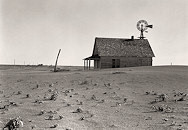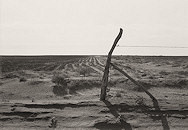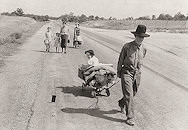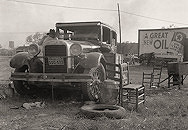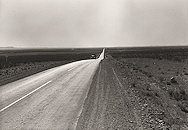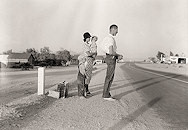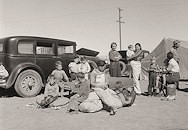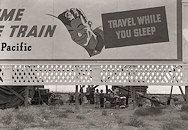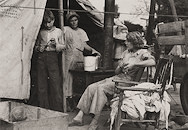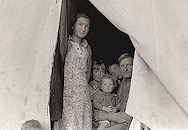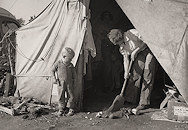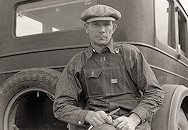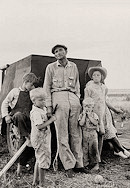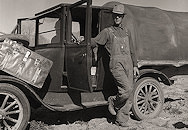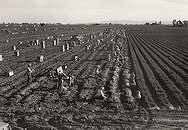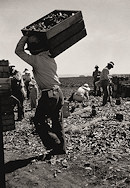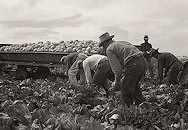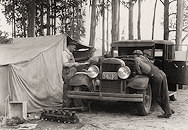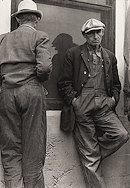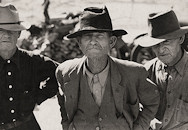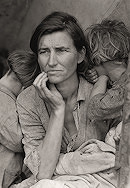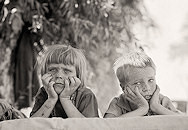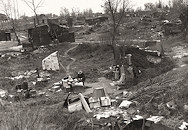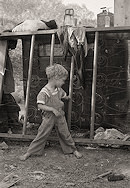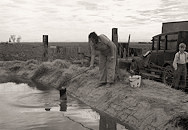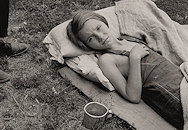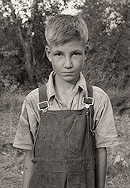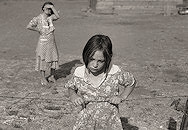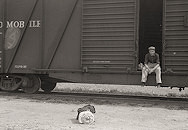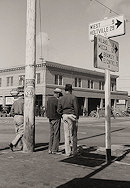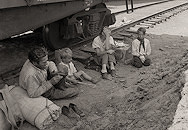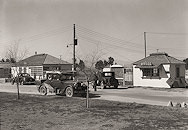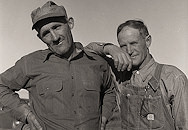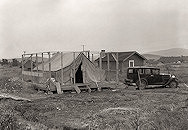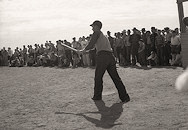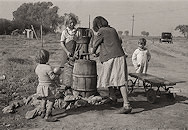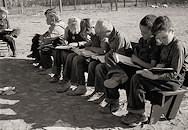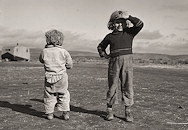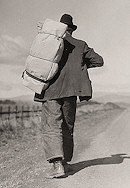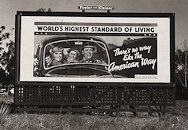![]()

Migrant Farm Families
Photos with Original Captions
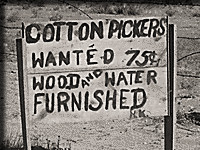
Dorothea Lange (1895-1965) has been called America's greatest documentary photographer. She is best known for her chronicles of the Great Depression and for her photographs of migratory farm workers. Below are 42 pre-World War II photographs she created for the U.S. Farm Security Administration (FSA) investigating living conditions of farm workers and their families in Western states such as California. Most of the workers had come west to escape the Dust Bowl, the lengthy drought which devastated millions of acres of farmland in Midwestern states such as Oklahoma.
![]()
Scenes from the Dust Bowl -- Left - A Dust Bowl farm. Coldwater District, north of Dalhart, Texas. This house is occupied; most of the houses in this district have been abandoned. Mid - Drought-stricken farmer and family near Muskogee, Oklahoma. Agricultural day laborer. Muskogee County. Right - Furrowing against the wind to check the drift of sand. Dust Bowl, north of Dalhart, Texas.
On the Road -- Left - Family walking on highway, five children. Started from Idabel, Oklahoma. Bound for Krebs, Oklahoma. Pittsburg County, Oklahoma. In 1936 the father farmed on thirds and fourths at Eagleton, McCurtain County, Oklahoma. Was taken sick with pneumonia and lost farm. Unable to get work on Work Projects Administration and refused county relief in county of fifteen years residence because of temporary residence in another county after his illness. Mid - Wagoner County, Oklahoma. Right - The highway going West. U.S. 80 near Lordsburg, New Mexico.
California at Last -- Left - Example of self-resettlement in California. Oklahoma farm family on highway between Blythe and Indio. Forced by the drought of 1936 to abandon their farm, they set out with their children to drive to California. Picking cotton in Arizona for a day or two at a time gave them enough for food and gas to continue. On this day, they were within a day's travel of their destination, Bakersfield, California. Their car had broken down en route and was abandoned. Mid - Four families, three of them related with fifteen children, from the Dust Bowl in Texas in an overnight roadside camp near Calipatria, California. Right - Billboard along U.S. 99 behind which three destitute families of migrants are camped. Kern County, California.
Tents as Home -- Left - Drought refugees from Texas encamped in California near Exeter. Seven in family. Mid - Brawley, Imperial Valley, In Farm Security Administration (FSA) migratory labor camp. Right - In a carrot pullers' camp near Holtville, California.
![]()
Waiting for Work -- Left - 1936 drought refugee from Polk, Missouri. Awaiting the opening of orange picking season at Porterville, California. Mid - Old time professional migratory laborer camping on the outskirts of Perryton, Texas at opening of wheat harvest. With his wife and growing family, he has been on the road since marriage, thirteen years ago. Migrations include ranch land in Texas, cotton and wheat in Texas, cotton and timber in New Mexico, peas and potatoes in Idaho, wheat in Colorado, hops and apples in Yakima Valley, Washington, cotton in Arizona. He wants to buy a little place in Idaho. Right - Ex-tenant farmer from Texas, came to work in the fruit and vegetable harvests. Coachella Valley, California.
In the Fields -- Left - Near Meloland, Imperial Valley. Large scale agriculture. Gang labor, Mexican and white, from the Southwest. Pull, clean, tie and crate carrots for the eastern market for eleven cents per crate of forty-eight bunches. Many can make barely one dollar a day. Heavy oversupply of labor and competition for jobs is keen. Mid - Carrot pullers from Texas, Oklahoma, Arkansas, Missouri and Mexico. Coachella Valley, California. "We come from all states and we can't make a dollar a day in this field noways. Working from seven in the morning till twelve noon we earn an average of thirty five cents." Right - Cabbage cutting and hauling by new Vessey (flat truck) system, now also used in carrots and lettuce. Imperial Valley, California.
![]()
Little Money -- Left - Pea pickers from Vermont - 6 weeks earnings $7.00 - at squatter's camp, Nipomo. Mid - Waiting for the semimonthly relief checks at Calipatria, Imperial Valley, California. Typical story: fifteen years ago they owned farms in Oklahoma. Lost them through foreclosure when cotton prices fell after the war. Became tenants and sharecroppers. With the drought and dust they came West, 1934-1937. Never before left the county where they were born. Now although in California over a year they haven't been continuously resident in any single county long enough to become a legal resident. Reason: migratory agricultural laborers. Right - Ex-tenant farmer on relief grant in the Imperial Valley, California.
![]()
Toll of Uncertainty -- Left - Destitute pea pickers in California. Mother of seven children. Mid - Children of Oklahoma drought refugee in migratory camp in California. Right - A mother in California who with her husband and her two children will be returned to Oklahoma by the Relief Administration. This family had lost a two-year-old baby during the winter as a result of exposure.
![]()
Unhealthy Lifestyle -- Left - Migrant workers' camp, outskirts of Marysville, California. The new migratory camps now being built by the Resettlement Administration will remove people from unsatisfactory living conditions such as these and substitute at least the minimum of comfort and sanitation. Mid - Son of destitute migrant, American River camp, near Sacramento, California. The boy has dysentery. Right - Water supply: an open settling basin from the irrigation ditch in a California squatter camp near Calipatria.
![]()
Childhood Interrupted -- Left - Sick migrant child. Washington, Yakima Valley, Toppenish. Mid - Migratory boy in squatter camp. Has come to Yakima Valley for the third year to pick hops. Mother: "You'd be surprised what that boy can pick." Washington, Yakima Valley. Right - Washington, Yakima Valley, near Wapato. One of Chris Adolph's younger children. Farm Security Administration Rehabilitation clients.
![]()
On the Move -- Left - Car on siding across tracks from pea packing plant. Twenty-five year old itinerant, originally from Oregon. "On the road eight years, all over the country, every state in the union, back and forth, pick up a job here and there, travelling all the time." Calipatria, Imperial Valley. Mid - Calipatria, Imperial Valley. Idle pea pickers discuss prospects for work. California. Right - Family who traveled by freight train. Washington, Toppenish, Yakima Valley.
Finding Alternatives -- Left - Entering Farm Security Administration (FSA) camp for migratory laborers at Indio. Coachella Valley, California. Mid - Heads of families on the Mineral King cooperative farm. Ten families are now established on this 500-acre ranch to be operated as a unit. (Farm Security Administration) Tulare County, California. Right - Family living in tent while building the house around them. Near Klamath Falls, Klamath county, Oregon.
Striving for Normalcy -- Left - Ball game. Shafter migrant camp. California. Mid - Water supply, American River camp, California, San Joaquin Valley. Right - Eight boys at Lincoln Bench School. Born in six states. Near Ontario, Malheur County, Oregon.
![]()
Enduring Life -- Left- Migrant children. Merrill, Klamath County, Oregon. In unit of FSA (Farm Security Administration) mobile camp. Mid - Migrant worker on California highway. Right - Billboard on U.S. Highway 99 in California. National advertising campaign sponsored by National Association of Manufacturers.
[ The History Place Main Page | American Revolution | Abraham Lincoln | American Civil War | Child Labor in America 1908-1912 | U.S. in World War II in the Pacific | John F. Kennedy Photo History | The Rise of Adolf Hitler | The Triumph of Hitler | Defeat of Hitler | Hitler Youth | Timeline of World War II in Europe | Holocaust Timeline | Photo of the Week | This Month in History | Advertise | Send Feedback ]
Copyright © 2012 The History Place™ All Rights Reserved
Terms of use: Private home/school non-commercial, non-Internet re-usage only is allowed of any text, graphics, photos, audio clips, other electronic files or materials from The History Place.
